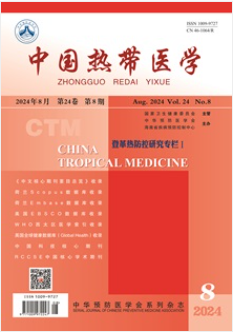Clinical analysis of 39 imported malaria cases
引用次数: 0
Abstract
Objective To analyze the clinical characteristics, results of laboratory examination and treatment strategies of patients with imported malaria, to provide experience for malaria prevention, control, diagnosis and treatment. Methods Collected clinical data of 39 imported malaria patients admitted to the First Affiliated Hospital of Guangxi Medical University from July 2012 to December 2019, the patient’s general condition, clinical manifestations, laboratory examinations, diagnosis and treatment were retrospectively analyzed. Results The 39 patients included 37 males and 2 females. Their average age was (38.79±9.74) years old. There were 20 cases with falciparum malaria, 3 cases with vivax malaria, 2 cases with mixed infection by falciparum malaria and vivax malaria, 1 case with malaria ovale, 1 case with malariae infection, and 12 cases with unknown type. All patients had fever symptoms. The common symptoms included fatigue (74.36%), headache (33.33%), splenomegaly (30.77%), nausea and vomiting (28.21%), et al. Complications occurred in 17 patients. After treatment, the patient’s hemoglobin level [(99.94±23.06) g/L] was lower than before treatment [(116.97 ±28.30) g/L], the difference was statistically significant ( t =2.6561, P <0.05), and platelets increased in after treatment [(209.24 ± 100.31)×10 9 /L] compared to before treatment [(102.12 ± 86.98)×10 9 /L], the difference was statistically significant ( t =–4.6801, P <0.001). Thirty-eight patients were treated with artesunate-based treatment. Except for one death, the rest were cured and discharged. Conclusion Falciparum malaria is the main infectious species in imported malaria cases, which has many complications. Early identification and diagnosis of malaria is the key to treatment. The phenomenon of increased platelets and decreased hemoglobin after treatment of imported malaria is of significant significance and is worthy of further study. 摘要:目的 分析输人性疟疾患者的临床特征,实验室检査结果及治疗策略,为疟疾防控及诊治提供经验。 方法 收集2012年7月至2019年12月广西医科大学第一附属医院收治的39例输人性疟疾患者的临床资料,对患者的 一般情况、临床表现、实验室检査 、 诊断治疗情况等进行回顾性分析。 结果 39例患者中男性37例,女性2例,平均年 龄(38.79±9.74)岁。其中,恶性疟20例,间日疟3例,恶性疟混合间日疟2例,卵形疟1例,三日疟1例,分型不详12例。所有患者均有发热症状,乏力(占74.36%)、头痛(占33.33%)、脾大(占30.77%)、恶心呕吐(占28.21%)等为常见临床症 状,17例患者出现相关并发症。患者经治疗后血红蛋白水平[(99.94±23.06)g/L]较治疗前[(116.97±28.30)g/L]降低,差异 有统计学意义 t =2.6561, P <0.05),血小板[(209.24±100.31)×10 9 /L]较治疗前[(102.12±86.98)×10 9 /L]升高,差异有统计学 意义( t =-4.6801, P <0.001)。38例患者选用以青蒿琥酯为基础的治疗,除1例恶性疟重症患者死亡外,其余患者治愈出 院。 结论 输人性疟疾感染虫种主要是恶性疟原虫,常合并多种并发症,尽早识别及诊断疟疾是治疗的关键。其治疗 后出现血小板升高和血红蛋白降低具有显著意义,值得进一步研究。39例输入性疟疾临床分析
目的分析输入性疟疾患者的临床特点、实验室检查结果及治疗策略,为疟疾的预防、控制、诊断和治疗提供经验。方法收集2012年7月至2019年12月广西医科大学第一附属医院收治的39例输入性疟疾患者的临床资料,对患者的一般情况、临床表现、实验室检查、诊断和治疗进行回顾性分析。结果39例患者中男性37例,女性2例。平均年龄(38.79±9.74)岁。恶性疟20例,间日疟3例,恶性疟与间日疟混合感染2例,卵圆疟1例,疟疾感染1例,不明类型12例。所有患者均有发热症状。常见症状包括疲劳(74.36%)、头痛(33.33%)、脾肿大(30.77%)、恶心呕吐(28.21%)等。17例出现并发症。治疗后患者血红蛋白水平[(99.94±23.06)g/L]低于治疗前[(116.97±28.30)g/L],差异有统计学意义(t =2.6561, P <0.05);治疗后血小板水平[(209.24±100.31)×10 9 /L]较治疗前[(102.12±86.98)×10 9 /L]升高,差异有统计学意义(t = -4.6801, P <0.001)。38例患者接受以青蒿琥酯为基础的治疗。除一人死亡外,其余均痊愈出院。结论恶性疟是输入性疟疾病例的主要传染源,并伴有多种并发症。疟疾的早期发现和诊断是治疗的关键。输入性疟疾治疗后出现血小板升高、血红蛋白降低的现象具有重要意义,值得进一步研究。摘要:目的 分析输人性疟疾患者的临床特征,实验室检査结果及治疗策略,为疟疾防控及诊治提供经验。 方法 收集2012年7月至2019年12月广西医科大学第一附属医院收治的39例输人性疟疾患者的临床资料,对患者的 一般情况、临床表现、实验室检査 、 诊断治疗情况等进行回顾性分析。 结果39例患者中男性37例,女性2例,平均年龄(38.79±9.74)岁。其中,恶性疟20例,间日疟3例,恶性疟混合间日疟2例,卵形疟1例,三日疟1例,分型不详12例。所有患者均有发热症状,乏力(占74.36%),头痛(占33.33%),脾大(占30.77%),恶心呕吐(占28.21%)等为常见临床症状,17例患者出现相关并发症。患者经治疗后血红蛋白水平((99.94±23.06)g / L)较治疗前[(116.97±28.30)g / L]降低,差异有统计学意义t = 2.6561, P < 0.05),血小板[(209.24±100.31)×10 9 / L)较治疗前[(102.12±86.98)×10 9 / L)升高,差异有统计学意义(t = -4.6801, P < 0.001)。38例患者选用以青蒿琥酯为基础的治疗,除1例恶性疟重症患者死亡外,其余患者治愈出 院。 结论 输人性疟疾感染虫种主要是恶性疟原虫,常合并多种并发症,尽早识别及诊断疟疾是治疗的关键。其治疗 后出现血小板升高和血红蛋白降低具有显著意义,值得进一步研究。
本文章由计算机程序翻译,如有差异,请以英文原文为准。
求助全文
约1分钟内获得全文
求助全文
来源期刊
CiteScore
0.60
自引率
0.00%
发文量
13927
期刊介绍:
China Tropical Medicine, was approved by the Ministry of Science and Technology in 2001, is the only tropical medicine periodical under the charge of the National Health Commission of China. It’s organized by Hainan Provincial Center for Disease Prevention and Control, and Chinese Preventive Medicine Association.
The journal is indexed by the following database: Scopus database, Embase database, EBSCO Database, The Western Pacific Region index medicus (WPRIM), American Chemical Abstracts (CA), International Centre for Agricultural and Biological Sciences Research Database (CABI), Global Health Database, Database of the Ulrich's Periodicals Directory, China Science and Technology Core Journals, China Core Journals (Selection) Database, Database of Chinese Biomedical Literature, Comprehensive Evaluation Database of Chinese Academic Journals, CAJCD Code of Conduct Excellent Journal, Database of Chinese SCI-Tech Periodicals, China Journal Full Text Database.

 求助内容:
求助内容: 应助结果提醒方式:
应助结果提醒方式:


